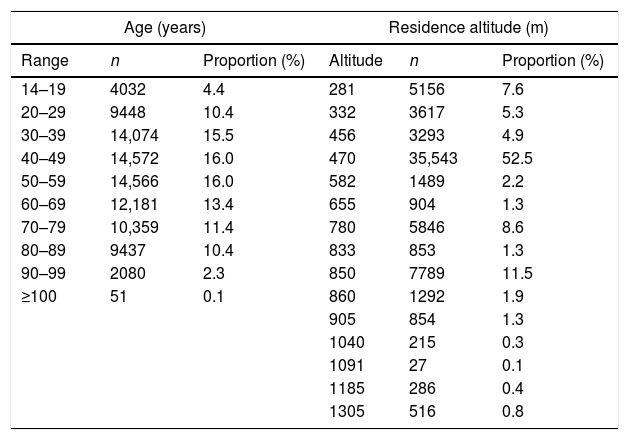There are gaps in our knowledge of the normative levels of haemoglobin and the prevalence of anaemia in our geographical area, and in certain population subgroups.
ObjectivesTo study the mean values of haemoglobin in a mountainous Spanish region, according to sex, age range and residence altitude, and the prediction of anaemia according to the WHO thresholds and other proposals.
Material and methodsCross-sectional descriptive study of all patients aged >14 residents in the Huesca healthcare Sector with ≥1 laboratory report in the 5 years of inclusion; multivariate analysis to determine the influence of demographic factors on haemoglobin values.
Results583,856 laboratory reports of 90,800 patients (coverage 89.1%) residing between 281 and 1305m: 54.6% female; mean age 52.6 years. Hb mean: 14.1g/dl (males: 15.0/females: 13.4). Prevalence of anaemia: 8.99% (males: 7.8%/females: 10.0%). It was more frequent in women (1.6 times) and increased markedly with age: >65 years: 16.5%; ≥75 years: 21.7%; ≥80 years: 25.7%; >90 years 35%. It increased 1.02 times per year, and 0.99 times per metre of altitude. In residents ≥1000m, anaemia prevalence fell by half.
ConclusionsWe obtained data from sub-populations that were previously not well described; anaemia in the elderly requires consideration. The influence of altitude does not seem to be fully considered within the correction framework proposed by WHO. Broader studies should be planned in order to obtain adequate parameters for the elderly and residents at high altitudes in Spain, as both groups represent an important proportion of the population, to avoid potential underdiagnosis of anaemia and overdiagnosis of other pathologies.
Existen lagunas respecto a los niveles normativos de hemoglobina y la prevalencia de anemia en nuestro entorno y en determinados subgrupos de población.
ObjetivosExaminar los valores medios de hemoglobina en una región española de orografía montañosa, según sexo, rango de edad y altitud de residencia, y la predicción de anemia según umbrales de la OMS y otras propuestas.
Material y métodosEstudio descriptivo transversal de todos los pacientes > 14 años del Sector Huesca con ≥ 1 analítica en los 5 años de inclusión; análisis multivariado para determinar la influencia de los factores demográficos en los valores de hemoglobina.
ResultadosSe incluyeron 583.856 informes analíticos de 90.800 pacientes (cobertura 89,1%) residentes entre 281 y 1.305 metros de altitud: 54,6% mujeres; edad media 52,6 años. Hemoglobina media: 14,1 g/dl (hombres:15,0/mujeres:13,4). Prevalencia de anemia: 8,99% (hombres: 7,8%/mujeres: 10,0%). Resultó más frecuente en mujeres (1,6 veces), y aumentaba llamativamente con la edad: > 65 años: 16,5%; ≥ 75 años: 21,7%; ≥ 80 años: 25,7%; > 90 años: 35%. Aumentaba 1,02 veces por cada año, y 0,99 veces por cada metro de altitud. En residentes a ≥ 1.000 m, descendía a la mitad.
ConclusionesSe obtuvieron datos de subpoblaciones previamente poco descritas; la anemia en población mayor requiere consideración. La influencia de la altitud no parece suficientemente abordada con la corrección de la OMS. Se deben plantear estudios amplios para definir criterios apropiados para edades avanzadas y residentes en altura en España, pues ambos grupos constituyen una proporción importante, para evitar incurrir potencialmente en infradiagnóstico de anemia y supradiagnóstico de otras patologías.












